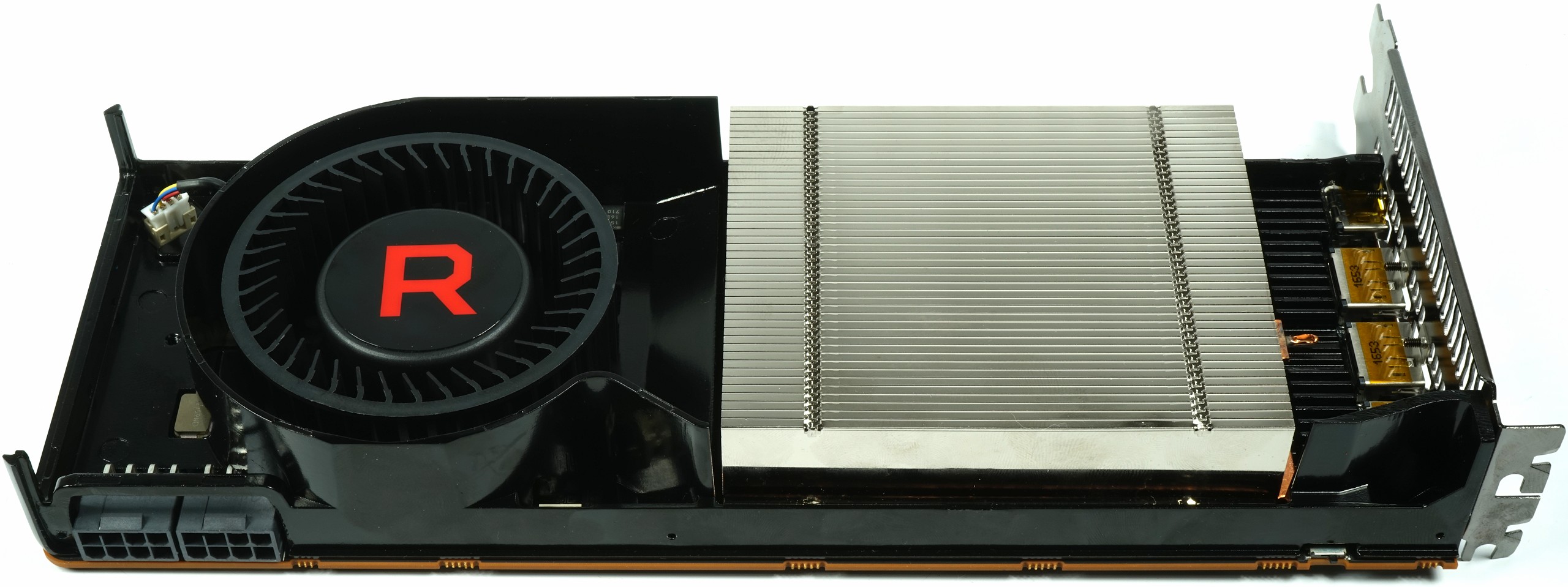AMD Radeon Vega RX 64 8GB Review
Why you can trust Tom's Hardware
Disassembly, Cooler & Interposer
Disassembly & Cooler
Some tools are needed to remove the card's cover. Six small screws that hold the shroud in place can be unfastened with a Phillips-head screwdriver. This reveals AMD's cooler, along with a frame responsible for adding rigidity and dissipating thermal energy.
AMD leans on a direct heat exhaust cooler again, and that's not a bad thing. We can see the radial fan sitting in its chamber, which brings in air from the case. This flow passes horizontally though the sink’s body and blows out of the card’s right slot cover.
The backplate is made from black anodized aluminum. Looking good is its only purpose, meaning it doesn't help with cooling. Our attempt to make the backplate functional with thermal pads didn't get us very far; they didn't draw much waste heat away from the board.
Up top, there's a massive cooling frame that helps keep the card's structure rigid. It also looks like AMD implemented some of the design lessons it learned from past generations. Similar to Gigabyte's Aorus GeForce GTX 1080 Ti Xtreme Edition, the chokes transfer heat to the frame through thermal pads. Indentations in the metal also accommodate voltage regulation circuitry.

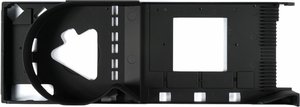
The heat sink’s body is made of thin aluminum cooling fins attached to a large copper vapor chamber. Toward the bottom of the following two pictures, you can see the chamber's outlet, which was soldered shut and should never be snapped off. A large protrusion on the copper plate's surface is situated perfectly to make contact with AMD's GPU/memory package.
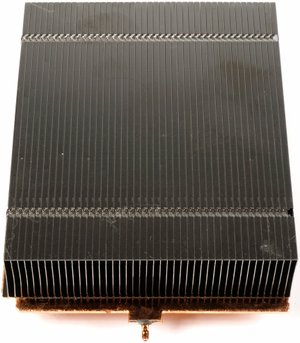
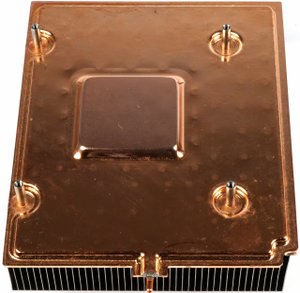
The 7cm radial fan is a simple ball bearing-based model from Delta. This is a first for AMD, and it’s certainly nice to see after generations of loud fans on the company's reference cards. Whereas those old fans spun at up to 10,000 RPM, the new BVB1012-family model hits its maximum speed at 5000 RPM. AMD’s target is around 40 to 41% duty cycle, translating to ~2000 RPM. The resulting acoustic profile makes Radeon RX Vega 64 sound similar to Nvidia's Founders Edition boards.


With the board completely exposed, all eyes turn to AMD's GPU and the HBM2 mounted together on an interposer, which sits on a large package substrate.
Get Tom's Hardware's best news and in-depth reviews, straight to your inbox.

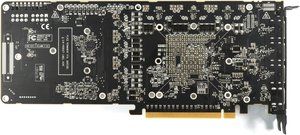
Of course, the GPU can't simply be soldered to the PCB. As with AMD's Fiji-based cards, Vega and its complement of memory go through a packaging process that's handled by specialty tools from companies like ASE. The resulting module is much easier for board partners to handle later on.
In the image below, you see the package as it was presented internally at AMD to its partners. There are deep channels between the GPU and memory modules since all three components are fairly tall. Conversely, the interposer is extremely thin and easy to break. That's why AMD warns everyone who touches the module to be careful when removing its thermal paste.
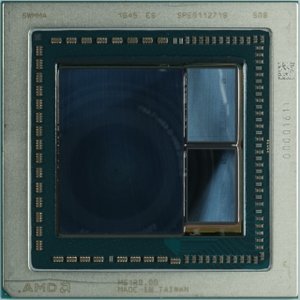
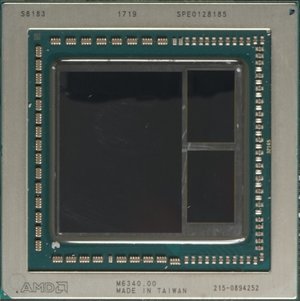
Leaving the package this way for the automated production line would have risked manufacturing issues. But compare that early shot to the shipping module. AMD appears to have added molding. Filling the area around the GPU and HBM2 with a suitable material increases the package's structural integrity.
You should still be careful when handling AMD's new GPU, particularly if a cooler swap is planned. However, it looks like the company put a lot of effort into making sure its unique layout is just as robust as more traditional designs.
MORE: Best Graphics Cards
MORE: Desktop GPU Performance Hierarchy Table
MORE: All Graphics Content
Current page: Disassembly, Cooler & Interposer
Prev Page Vega Architecture & HBM2 Next Page Board Layout & Components-
10tacle We waited a year for this? Disappointing. Reminds me of the Fury X release which was supposed to be the 980Ti killer at the same price point ($649USD if memory serves me correctly). Then you factor in the overclocking ability of the GTX 1080 (Guru3D only averaged a 5% performance improvement overclocking their Vega RX 64 sample to 1700MHz base/boost clock and a 1060MHz memory clock). This almost seems like an afterthought. Hopefully driver updates will improve performance over time. Thankfully AMD can hold their head high with Ryzen.Reply -
Sakkura For today's market I guess the Vega 64 is acceptable, sort of, since the performance and price compare decently with the GTX 1080. It's just a shame about the extreme power consumption and the fact that AMD still has no answer to the 1080 Ti.Reply
But I would be much more interested in a Vega 56 review. That card looks like a way better option, especially with the lower power consumption. -
envy14tpe Disappointing? what. I'm impressed. Sits near a 1080. Keep that in mind when thinking that FreeSync sells for around $200 less than Gsync. So pair that with this GPU and you have awesome 1440p gaming.Reply -
SaltyVincent This was an excellent review. The Conclusion section really nailed down everything this card has to offer, and where it sits in the market.Reply -
10tacle Reply20060001 said:Disappointing? what. I'm impressed. Sits near a 1080.
The GTX 1080 has been out for 15 months now, that's why. If AMD had this GPU at $50 less then it would be an uncontested better value (something AMD has a historic record on both in GPUs and CPUs). At the same price point however to a comparable year and three month old GPU, there's nothing to brag about - especially when looking at power use comparisons. But I will agree that if you include the cost of a G-Sync monitor vs. a FreeSync monitor, at face value the RX 64 is the better value than the GTX 1080. -
redgarl It`s not a bad GPU, however I would not buy one. I am having an EVGA 1080 FTW that I am living to hate (2 RMAs in 10 months), however even if I wanted to switch to Vega, might not be a good idea. It will not change anything.Reply
However two Vega 56 in CF might be extremely interesting. i did that with two 290x 2 years ago and it might be still the best combo out there. -
blppt IIRC, both AMD and Nvidia are moving away from CF/SLI support, so you'd have to count on game devs supporting DX12 mgpu (not holding my breath on that one for the near future).Reply -
cknobman I game at 4k now (just bought 1080ti last week) and it appears for the time being the 1080ti is the way to go.Reply
I do see promise in the potential of this new AMD architecture moving forward.
As DX12 becomes the norm and more devs take advantage of async then we will see more performance improvements with the new AMD architecture.
If AMD can get power consumption under control then I may move back in a year or two.
Its a shame too because I just built a Ryzen 7 rig and felt a little sad combining it with an Nvidia gfx card. -
AgentLozen I'm glad that AMD has a video card for enthusiasts who run 144hz monitors @ 1440p. The RX 580 and Fury X weren't well suited for that. I'm also happy to see that Vega64 can go toe to toe with the GTX 1080. Vega64 and a Freesync monitor are a great value proposition.Reply
That's where the positives end. I'm upset with the lack of progress since Fury X like everyone else. There was a point where Fury X was evenly matched with nVidia's best cards during the Maxwell generation. Nvidia then released their Pascal generation and a whole year went by before a proper response from AMD came around. If Vega64 launched in 2016, this would be totally different story.
Fury X championed High Bandwidth Memory. It showed that equipping a video card with HBM could raise performance, cut power consumption, and cut physical card size. How did HBM2 manifest? Higher memory density? Is that all?
Vega64's performance improvement isn't fantastic, it gulps down gratuitous amounts of power, and it's huge compared to Fury X. It benefits from a new generation of High Bandwidth memory (HBM2) and a 14nm die shrink. How much more performance does it receive? 23% in 1440p. Those are Intel numbers!
Today's article is a celebration of how good Fury X really was. It still holds up well today with only 4GB of video memory. It even beat the GTX 1070 is several benchmarks. Why didn't AMD take the Fury X, shrink it to 14nm, apply architecture improvements from Polaris 10, and release it in 2016? That thing would be way better than Vega64.
edit: Reworded some things slightly. Added a silly quip. 23% comes from averaging the differences between Fury X and Vega64. -
zippyzion Well, that was interesting. Despite its flaws I think a Vega/Ryzen build is in my future. I haven't been inclined to give NVidia any of my money for a few years now, since a malfunction with an FX 5900 destroyed my gaming rig... long story. I've been buying ATI/AMD cards since then and haven't felt let down by any of them.Reply
Let us not forget how AMD approaches graphics cards and drivers. This is base performance and baring any driver hiccups it will only get better. On top of that this testing covers the air cooled version. We should see better performance on the water cooled version that would land it between the 1080 and the Ti.
Also, I'd really like to see what low end and midrange Vega GPUs can do. I'm interested to see what the differences are with the 56, as well as the upcoming Raven Ridge APU. If they can deliver RX 560 (or even just 550) performance on an APU, AMD will have a big time winner there.

